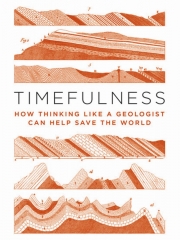Timefulness by Marcia Bjornerud
This book is a quick overview of geology and the history of Earth, served with a side of climate change commentary. Like A Brief History of Time, it was manageable at the start, but as it went deeper into the science, I couldn’t really keep up. You understand 90% of chapter 1, 80% of chapter 2, and it quickly falls apart once you have to put different concepts together.
1) James Hutton discovered a discontinuity between two sequences of rocks at Siccar Point, and this led to the foundational concept of uniformitarianism.
Even though it seems obvious now, the idea that the same geologic processes have been going on for billions of years was groundbreaking (pun).
2) Mary Anning – a fossil collector – probably inspired the “She sells seashells” tongue twister.
Why doesn’t her name start with an S?
3) Global Boundary Stratigraphic Section and Points, or golden spikes, are chosen as international standards for boundaries of geologic stages.
This sounds like a fun trip around the world.
4) Above-ground nuclear testing and fossil fuel burning have both complicated radiocarbon dating.
The latter is called the Suess effect.
5) The Chicxulub crater was caused by the asteroid that killed the dinosaurs.
Recently I’ve been reading a lot of science fiction and nonfiction. The one common theme is how helpless humans are.
6) Decompression melting is how mantle becomes magma as rocks rise towards the surface.
Even though the temperature is cooling, the decreasing pressure causes the rock to melt.
7) Seafloor spreading is generally faster in the Pacific Ocean compared to the Atlantic Ocean.
This is because of subduction zones where the sea floor gets “slab pulled” back into Earth.
8) More rock has been removed from the Himalayas through erosion than the current size of the mountains.
Paradoxically, erosion decreases the weight of the crust, which means that the mantle flows back underneath and the mountain rises.
9) Oxygen interacted with iron dissolved in the ocean to create iron formations.
After this, free oxygen became available and changed the entire atmosphere during the Great Oxidation Event.
10) The formation of limestone involves combining calcium with carbon dioxide.
It was cool to learn how seashell organisms are part of the carbon cycle.
I was interested enough in geology to read this book, but I don’t think it inspired me to learn more. It was too hard to follow what’s going on and when. The best parts were the illustrations – pictures are indeed worth a thousand words when we’re talking about rocks.
